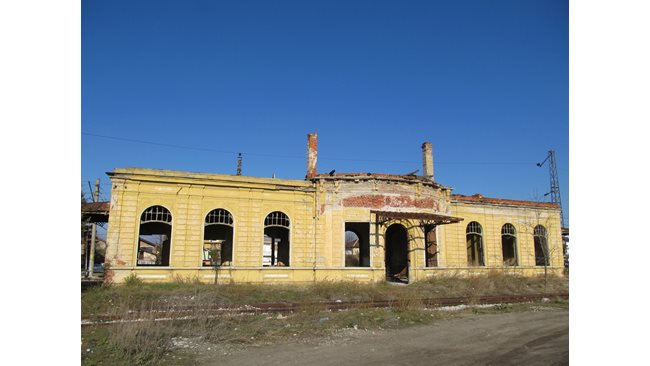Now the Viennese-style building is dilapidated, dirty, with broken doors and windows, a home for drug addicts and the homeless.
14 days before he was assassinated in Marseilles, King Alexander of Serbia came to Bulgaria
Beautiful rectangular building in typical Viennese style. From the entrance there is a view of the two halls. The floor is painted with glazed ocher ceramic floor tiles, and the wallpapers combine different ornaments.

From the royal station Tsar Ferdinand left Bulgaria for good.
–
The magnificent arched windows and the rich ornamentation on the facade, especially exquisite on the two entrance arches, suggest an unusual architectural thought.
Cast iron columns with decorative capitals,
supporting the roof and the visors, connecting exquisite cornices. In special cylindrical niches there are also two tiled stoves, against which large wicker armchairs are located. Outside, there are special places for the royal carriages, and in the 1930s a metal awning was installed above the southern entrance of the building – a completely new technology at the time.
This is what the majestic Royal Railway Station in Kazichene looked like, built by King Ferdinand to be close to Vrana. In fact, it was an essential part of Bulgaria’s relationship with Europe.
Today there is no fleeting memory of the exquisite architecture, and its designer remains unknown. The building is dilapidated, dirty, with broken doors and windows.
Parts are missing from the roof
Bottles, rags, condoms, syringes are thrown on the ground … Several torn, urine-smelling mattresses complete the interior of the Royal Railway Station, which today houses drug addicts and homeless people. Long ago on the walls
there is no trace of beautiful wallpaper
Swastikas and genitals are painted in their place.
Jewelry from the last century is about to be lost today. The battle for the restoration of the Royal Station began in 2008, after attempts were made to demolish it.
Then citizens signal that heavy equipment has been brought around the building and there are workers. The mayor of Kazichene, Anton Vladimirov, managed to stop the process and found that none of the local authorities had been notified of the plans.
An emergency procedure is started,
with which on February 25, 2009 the station was declared a cultural monument.
However, this does not change things. The building continues to collapse, and the institutions are constantly passing the ball to who is responsible for its restoration.
A petition for repairs is currently under way again, and citizens are trying
to save her from demolition
In recent years, the topic of the condition of the Royal Station has been raised several times, but there is no reaction.
Therefore, in 2017 a civil association contacted the prosecutor’s office, and later it became clear that the site is owned by the National Railway Infrastructure Company (NRIC), but the building itself is not their responsibility.
The regional governor Nikolay Pehlivanov then claimed that the municipal administrations in the person of the mayors or the Ministry of Culture have a commitment to protect and manage the buildings, which are cultural monuments.
The institution explained that they have not been granted rights to manage the site.
In October, they inspected the building and said they found serious damage to the site in addition to poor condition. That is why they notified the regional governor of Sofia district, who
must eliminate all harmful consequences
from the identified irregularities. However, it is not clear whether a restoration procedure will be launched after that.
“After 1960, this building was abandoned and neglected. All institutions transfer responsibility – the mayor of Kazichene Grigor Grigorov is categorical. – The Sofia Municipality has repeatedly sought a solution to the problem. Attempts are being made to change the status of the building, which does not even have a notary. act. “
Documents indicate that after 1946 from the Royal Station
depart forcibly
in exile Simeon, his sister Maria Louise and their mother Queen Joanna, the property was confiscated “for the benefit of the people” and changed its purpose many times. It became a warehouse, an army headquarters, an office of Toplivo. Then they cut off the visor at the entrance.
On November 17, 1981 the building was assigned to the Regional People’s Council “Ninth of September”, falling into today’s municipality of Pancharevo.
Reports show that
until the 90s the Royal Station managed to survive
in decent condition, after which it was left to crumble.
In fact, King Ferdinand decided to build the building after the Vrana Palace was ready. In the early twentieth century, 9 km from the capital, the king bought an old Turkish farm, and then a few more plots of land to form a large property. He decides to name it after this bird, which first lands on its roof, and so the out-of-town royal residence acquires the name “Crow”. He spent most of his time there with his family. That is why he decided that his guests from abroad should not come all the way from Central Station in a carriage. He erected the small neat building in Kazichene, from where a narrow-gauge railway transported the tallest people in 10 minutes.
When the construction starts and which foreign guests the Royal Railway Station welcomed, read HERE.
– .


:format(jpg):watermark(https://f.elconfidencial.com/file/bae/eea/fde/baeeeafde1b3229287b0c008f7602058.png,0,274,1)/https://f.elconfidencial.com/original/10b/a8d/fd5/10ba8dfd57b58b0e71d65df3c680a8ca.jpg)